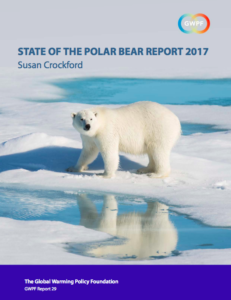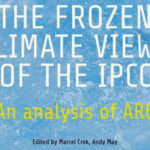Susan Crockford is een Canadese zoöloge, die bekend is geworden door haar opvattingen over de staat waarin de ijsberenpopulatie zich bevindt. In tegenstelling tot een aantal van haar collega’s is zij van mening dat het goed gaat met de ijsberen.
Naar aanleiding van een lasterlijk aanval op haar wetenschappelijke competentie en integriteit van een aantal wetenschappers onder aanvoering van de Wageningse klimaatinquisiteur Jeff Harvey schonk ik eerder aandacht aan haar opvattingen.
 Onlangs heeft de ‘Global Warming Policy Foundation’ (GWPF) een rapport van haar gepubliceerd, waarin zij haar bevindingen nader heeft uitgewerkt.
Onlangs heeft de ‘Global Warming Policy Foundation’ (GWPF) een rapport van haar gepubliceerd, waarin zij haar bevindingen nader heeft uitgewerkt.
Nagenoeg tegelijkertijd verscheen een opiniebijdrage van haar in de Canadese ‘Financial Times’. Ik pik er een aantal elementen uit.
Polar bears are flourishing, making them phony icons, and false idols, for global warming alarmists.
The polar bear’s resilience should have meant the end of its use as an icon of global warming doom.
Polar bears keep thriving even as global warming alarmists keep pretending they’re dying
One powerful polar bear fact is slowly rising above the message of looming catastrophe repeated endlessly by the media: More than 15,000 polar bears have not disappeared since 2005. Although the extent of the summer sea ice after 2006 dropped abruptly to levels not expected until 2050, the predicted 67-per-cent decline in polar bear numbers simply didn’t happen. Rather, global polar bear numbers have been stable or slightly improved. The polar bear’s resilience should have meant the end of its use as a cherished icon of global warming doom, but it didn’t. The alarmism is not going away without a struggle.
Part of this struggle involves a scientific clash about transparency in polar bear science. My close examination of recent research has revealed that serious inconsistencies exist within the polar bear literature and between that literature and public statements made by some researchers.
For example, Canadian polar bear biologist Ian Stirling learned in the 1970s that spring sea ice in the southern Beaufort Sea periodically gets so thick that seals depart, depriving local polar bears of their prey and causing their numbers to plummet. But that fact, documented in more than a dozen scientific papers, is not discussed today as part of polar bear ecology. In these days of politicized science, neither Stirling nor his colleagues mention in public the devastating effects of thick spring ice in the Beaufort Sea; instead, they imply in recent papers that the starving bears they witnessed are victims of reduced summer sea ice, which they argued depleted the bears’ prey. …
One reason that the 2007 predictions of future polar bear survival were so far off base is that the model developed by American biologist Steven Amstrup (now at Polar Bears International, an NGO) assumed any polar bear population decline would be caused by less summer ice, despite the Beaufort Sea experience. Moreover, Amstrup and fellow modelers were overly confident in their claim that summer ice was critical for the polar bear’s survival and they had little data on which to base their assumption that less summer ice would devastate the polar bears’ prey. ...
That starving-bear video may have convinced a few more gullible people that only hundreds of polar bears are left in the world. But it also motivated others to locate the International Union for Conservation of Nature (IUCN) Red List report for 2015 that estimated global polar bear numbers at somewhere between 22,000-31,000, or about 26,000, up slightly from 20,000-25,000, or about 22,500, in 2005. Newer counts not included in the 2015 assessment potentially add another 2,500 or so to the total. This increase may not be statistically significant, but it is decidedly not the 67-per-cent decline that was predicted given the ice conditions that prevailed.
 The failure of the 2007 polar bear survival model is a simple fact that explodes the myth that polar bears are on their way to extinction. Although starving-bear videos and scientifically insignificant research papers still make the news, they don’t alter the facts: Polar bears are thriving, making them phony icons, and false idols, for global warming alarmists.
The failure of the 2007 polar bear survival model is a simple fact that explodes the myth that polar bears are on their way to extinction. Although starving-bear videos and scientifically insignificant research papers still make the news, they don’t alter the facts: Polar bears are thriving, making them phony icons, and false idols, for global warming alarmists.
Zie verder hier.
Alweer een sprookje minder.






Ja het sprookje dat er een “lasterlijk aanval op haar wetenschappelijke competentie en integriteit van een aantal wetenschappers ” zou zijn geweest
Het blijft een feit dat ze geen wetenschappelijke publicatie op haar naam heeft staan als het gaat om de invloed van klimaatverandering op het wel en wee van ijsberen en dat ze de enige wetenschapper is waaraan gerefereeed wordt door de “sceptische” blogs
Kameraad Janos, bijna goed. Probeer nu eens inhoudelijk te reageren, of eigenlijk… laat maar zitten…
Ad hominem
Beste HenkDj, je reactie is ook een adhom. En dat is mijns inziens een (weliswaar zelfverklaarde) wetenschapper onwaardig. met vriendelijke groet, gekke henkie
Het blijft een feit dat jij al zeker 9 jaar reageert op klimaatsceptische blogs, maar dat je zelf nog nooit 1 blog hebt geschreven, laat staan dat je ook maar iets van een klimaatwetenschappelijk publicatie op je naam hebt staan. Jan, jij hebt tot nu toe werkelijk helemaal niks betekent voor klimaatwetenschap. 0,0, niks!
Het enige dat ik kan bedenken, jouw ascese heeft bijgedragen aan de polarisering tussen klimaatsceptici en klimaatalarmisten. Of je daar nou zo trots op mag zijn? Geen klimaatalarmist durft nog met jou op te trekken, je staat er helemaal alleen voor. (ik zou het zielig vinden als ik niet wist dat je er een kick van krijgt)
“je staat er helemaal alleen voor.”
Alhoewel ik het niet altijd eens ben met JvdH, vind ik toch dat hij de enige is op dit forum die alle harde feiten durft onder ogen te komen, en niet negeert wat hem niet aanstaat.
JvdH heeft gelijk dat Crockford geen wetenschappelijk onderzoek doet over ijsberen, maar zich toch als wetenschapper met expertise hierover probeert te profileren.
Beste HenkDj,
hier laat je wel heel erg duidelijk blijken dat je gewoon het alter ego bent van Janos. Om het volgende te stellen: “dat hij de enige is op dit forum die alle harde feiten durft onder ogen te komen, en niet negeert wat hem niet aanstaat.” Om zijn gemankeerde gedachten wereld te kunnen begrijpen moet je er in zitten en jij , HenkDj, zit er in. Vollgende keer een nick kiezen zonder “henk” in de text. “Mein Gott, wass bist Du fur ein doofes Schwein! ” met vriendelijke groet, gekke henkie
Merk op hoe het artikel begint: “Susan Crockford is een Canadese zoöloge, die bekend is geworden door haar opvattingen over de staat waarin de ijsberenpopulatie zich bevindt”
Dus bekend omwille van haar “opvattingen”. Niet omwille van haar “wetenschappelijk onderzoek”.
Ja, en?
Kijk eens naar mijn reactie “Henk dJ 8 maart 2018 om 20:29” (staat nog wel in moderatie – ik begrijp wel niet waarom, maar neem aan dat het zal aanvaard worden omdat het enkel feitelijk)
Is dat het enige wat je in te brengen hebt? Waarom geef je hier geen steekhoudend commentaar op het berenverhaal, of heb je dat niet? Àls je weer met een linkje komt, dan wel graag een hele goeie!
Oeps foute reply, maar deze is bedoeld voor jouw, broeder Janos!
Hmmmm
Hans verteld zijn verhaaltjes en ik reageer daarop
Het spijt me Susan Crockford heeft geen wetenschappelijke studie gemaakt op het gebied van klimaat verandering en ijsberen
Feit
Volgende, iedereen even nakijken, even schrijven ja Jan je had gelijk (zoals gewoonlijk) en dan gaan we daarna weer verder om te kijken wat er in het verhaal staat
Jan, gewetenloos herhaal je je verhaaltje weer eens, je kent geen schaamte. Het past voor jou natuurlijk mooi in je dagelijkse portie zelfkastijding, geniet er maar weer van!
He Tije
Jou heb ik nog nooit op inhoudelijk commentaar kunnen betrappen, niet als Tije en niet als T2000
Dat is maar goed ook Jan, dan weet ik in ieder geval zeker dat ik geen enkele inhoudelijke energie aan jou heb verspild.
Maar weer even in herhaling; wat een prutcommentaar lever je weer op deze site. Is dit echt het enige dat je kunt zeggen, kun je dan ook helemaal niks? Negen jaar lang alleen maar zeuren in de comments dat je inhoud mist, dat je onderbouwing wil; Wat een zwakte. Jan, je bakt er helemaal niks van, stop ermee.
Hoe voelt dit, wanneer ik dit zo op je afvuur? Of voel je niks? Morgen weer een dag, ben je alles weer vergeten, ga je weer om hetzelfde zeuren.
Er is voor jouw gedrag een naam, zoek even het linkje.
Beste Janos,ik heb nog nooit enige gepubliceerde, peer reviewed letter van je mogen waarnemen in de wetenschappelijke literatuur. Waarom denk je dan dat je degene bent die hier iedereen de maat meent te mogen nemen voor wat betreft de wetenschappelijkheid van hun opmerkingen? En exact dezelfde opmerking is van toepassing op je klonale echoput, HenkDj. Kom eens een keer met iets bijzonders,iets wat niet gestolen is van DesmogBlog, David, SS. Ga nu zelf eens denken. Hersenen, weet je, zitten tussen die flapjes aan weerszijden van je hoofd. Daar kun je iets heel bijzonders meedoen: denken! met vriendelijke groet, gekke henkie
Alweer de dagelijkse prietpraat van Troll Heyden!
/sarc,
nee, een zoöloge mag zich niet begeven op het vlak van ijsberen. Dat is voorbehouden aan klimaatwetenschappers
/sarc
Het sprookje minder gaat over de ijsbeer als kanarie in de kolenmijn van de klimaatwetenschap. Triest dat dit toch nog uitgelegd moet worden.
Sussan Crockford kan prima een verhaal vertellen over klimaatverandering en de invloed op ijsberen. Ze is daarvoor uitstekend gekwalificeerd!
Ik wacht dan ook met smart op haar publicatie over de invloed van klimaatverandering op de populatie van de ijsbeer.
Tot die tijd …….
Do Not Feed The Trolls !!
Sorry ik zal niet meer op Ivo reageren
Hetzelfde geldt voor de geoloog. Die moet ook z’n mond houden over het geologische verleden van de planeet. Zoals IJstijden, geschiedenis van zeeniveauveranderingen, atmosferische condities in bijvoorbeeld het Carboon, evolutie van zowel fauna en flora, vulkanisme en de uitstoot van gassen zoals CO2, geo-morfologische veranderingen als gevolg van het klimaat zoals gletsjers. Dat alles is nu het terrein van de moderne “klimatoloog” .
Het landjepik van de klimatologie begint inderdaad groteske vormen aan te nemen. Biologie, geologie en meteorologie worden zonder géne ingepalmd. Dat is normaal voor een ‘delinquent teenager’: verzet tegen de macht. https://www.amazon.com/Delinquent-Teenager-Mistaken-Worlds-Climate-ebook/dp/B005UEVB8Q
Maar waar andere wetenschappen gebruik maken van inzichten van anderen, methoden gebruiken die hun waarde bewezen hebben en bij tijd en wijle een hypothese formuleren, volstaat de klimatologie met ‘the science is settled’. Dat zullen alle andere takken van sport nooit zeggen, want daarmee sluit je voortschrijdend inzicht uit.
De klimatologie leent het GCM-model van de meteorologie, verklaart dat toepasbaar op het klimaat. Postuleert dat één factor van overheersend belang is en gaat de toekomst voorspellen, niet met 1 model, maar met meer dan 100. De uitkomsten daarvan worden voorgelegd aan een panel, dat vervolgens verklaart met x% waarschijnlijkheid de aarde in in 2050 y graden opgewarmd zal zijn als we zo doorgaan.
Dat is in mijn ogen geen wetenschap, maar dogma. En zolang er concensus is, blijft het dogma overeind.
Hoe het dogma’s kan vergaan, leert de geschiedenis van de sterrenkunde.
Toen Copernicus geconcludeerd had dat de sterrenkunde fout zat en dat de zon het middelpunt is, schreef hij dat heel voorzichtig op. Beducht als hij was voor de toorn van de Kerk. En inderdaad, toen 100 jaar later Galilei het openlijk zei, belandde hij nog net niet op de brandstapel.
En weer 400 jaar later gaf de Kerk haar fout toch toe.
De gelijkenis met de klimatologie is treffend. Copernicus was niet zo maar een sterrenkundige, hij was een kannunik die met veel succes de sterrenkunde bedreef.
De Paus wist dat en die zat met een probleem. De toenmalige kalender was een heel stuk uit de pas gaan lopen met de seizoenen. De boeren waren al lang aan het morren omdat ze volgens de kerkelijke kalender veel te laat moesten zaaien.
De vraag van de Paus aan hem was dan ook: hoe maken we een betere kalender?
Maar Copernicus schreef terug ‘Heilige Vader, dat weten wij niet’, terwijl hij ’De Revolutionibus’ al had geschreven, maar niet uitgegeven. Pas 30 jaar later drong een leerling daarop aan, vond niet in NL, maar pas in Zwitserland een uitgever.
Dat boek ging de wereld rond en de rest is geschiedenis. https://www.bol.com/nl/p/het-boek-dat-niemand-las/1001004002094142/
Sinds T.S. Kuhn is duidelijk dat wetenschapbeoefening niet in het luchtledige plaatsvindt, maar in een sociale context. https://en.wikipedia.org/wiki/The_Copernican_Revolution_(book)
De manier van denken, de axioma’s en de geldende theorie veranderen en de sociale context heeft daar invloed op. Of een verandering van paradigma kán, is niet alleen een kwestie voor wetenschappers. http://www.hup.harvard.edu/catalog.php?isbn=9780674171039
Bevrijd van de Kerk, hoop ik niet dat de klimaatkerk een lang leven beschoren zal zijn.
Als die klimaatwetenschappers nou eens beginnen met de Eerste en Tweede Hoofdwet van de Thermodynamica in hun hoofd prenten, praten we verder. Er is al zo weinig zeker.
Janner dat je die thermodynamica erbij haalt, de aarde is geen gesloten systeem.
http://www.drroyspencer.com/2014/04/skeptical-arguments-that-dont-hold-water/
Heeft die beer in de derde foto van boven nou een wolf vast?
Twan,
De beer heeft vriendschap gesloten met een husky.
Twan:
youtube.com/watch?v=JE-Nyt4Bmi8
Erg gaaf
Het gekissebis met J.van der Heijden schaadt de discussie op dit forum. Beter is de relevante conclusies te noteren en bediscussiëren. mijn conclusie uit bovenstaande is dat de ijsberen populatie bedreigd wordt bij een toenemende ijsdikte en bij een afnemende ijsdikte? En de populatie van de ijsberen is stabiel of licht groeiende? Is het verband dan veel ingewikkelder of is er helemaal geen verband ?
Ik heb zowel van Susan Crockford als van Amstrup onderzoeken gelezen over de populatieontwikkeling van de ijsberen. Van beiden moet ik zeggen dat het om degelijke onderzoeksmethoden gaat. Armstrup laat zien dat in het jaar 2004 en 2005 een aantal subpopulaties iets achteruit gegaan zijn. Dat waren de jaren waarin het oppervlak zomerijs minimaal was. Later heeft ie dat met modellen geextrapoleerd naar de situatie dat het zomerijs veel verder zou terugtrekken. Hij voorspelde dat in 2050 het zomerijs zover teruggetrokken zou zijn dat tot wel 60% van de ijsbeerpopulatie verdwenen zou zijn.
De situatie die hij voorspelde voor 2050 deed zich echter al veel eerder voor, En de 60% achteruitgang had zich niet voorgedaan.
Waar zit dan het verschil in benadering van dit probleem? Terwijl Amstrup de nadruk legde op het verdwijnen van het zomerijs wees Susan Crockford er op dat de dikte van het lente-ijs van veel groter belang is. Als dat te dik is (dat is geconstateerd voor 2004 en 2005) blijven de zadelrugrobben langer weg en dat is net de tijd dat ze jongen krijgen. Die jonge robben vormen het hoofdvoedsel van de ijsbeer vanwege hun hoge vetgehalte.
Blijkbaar is het voor de ijsbeer voldoende als ie zich in de lente voldoende vol kan vreten en met de opgehoopte vetreserves ook de zomer wel kan doorkomen. Of Amstrup of Crockford wel of geen klimaatwetenschappers zijn heeft met deze zaak niets van doen. Beiden gaan uit van dezelfde cijfers over het zomerijs. Daarover is geen meningsverschil.
Wat op de achtergrond meespeelde was de verwoede poging van Amstrup om de ijsbeer op de lijst van bedreigde diersoorten te krijgen. Maar de canadese autoriteit die daarover advies uitbrengt zag daar geen enkele aanleiding toe. Het onderzoek van Crockford was daar zeker niet beslissend in, maar het heeft de animositeit tussen haar en Armstrup zeker geen goed gedaan. Triest om te zien hoe het binnenhalen van onderzoeksgelden of het in stand houden van de ijsbeer als icoon van het alarmisme ten koste gaan van wetenschappelijke integriteit.
Het is veldonderzoek (dus kan er niets achter de komma verschijnen) over een beperkt gebied.
Op Antarctica heeft men een grote populatie van een kleine pinguinsoort “ontdekt” tegen alle alarmistische kreten in.
Populatiegrootte ongeveer 3,5 miljoen.
http://www.bbc.com/news/science-environment-43250744
Groene veldonderzoeken stellen niet zo veel voor.
Hans,
Ik heb het al eerder gezegd: de behandeling die Susan Crockford kreeg van Harvey c.s. was voor mij een eyeopener, ik had daarvoor helemaal niet opgelet en wist niet van het bestaan van climate wars.
Nu, na een paar maanden voeg ik daar aan toe: ik hield mezelf daarvoor onledig met vrolijker en meer ontspannen discussies.
Crockford kreeg geen behandeling, “sceptische” bloggers kregen een behandeling en ook als je het GWPF rapport leest erkent Susan Crockford dat de ijsberen het lastig gaan krijgen als het ijs gaat smelten,. En niemand met meer dan 2 hersencellen ontkent dat het ijs aan het smelten is en steeds minder wordt
“However, revised models for both now exist: new ice models predict nearly ice-free conditions
in summer before mid-century274 and a new polar bear survival model based on a new
method of classifying sea ice suggests that by mid-century, a 30% decline or more in polar bear
numbers should be expected – or at least that there is a 70% chance of such a decline.275 In other
words, experts now say we should expect an ice-free summer much earlier than previously predicted
but can anticipate that 10,000 or so fewer polar bears will die because of it”
https://www.thegwpf.org/content/uploads/2018/03/Polarbears2018-A.pdf
Je maakt niet dat je serieuzer wordt door iedere keer te verschijnen, Van der Heijden. Sterker, ook al ga je doen wat ik vind dat je moet doen, je zult voor mij van z’n levensdagen geen interessante gesprekspartner worden.
Maar, toegegeven, je hebt jezelf wel ontwikkeld: tot een stalker.
Nou ja, stalker … stalkertje.
Je durft niet naar mijn straat toe te komen.
Je beperkt je er toe, gebogen over je laptop, voor het luikje te gaan zitten.
Als zodanig ben je ook nog steeds zo betrouwbaar als dat ANWB-bord: we kunnen er op vertrouwen dat je ’s morgens, als eerste, het luikje opent, en dat jij ’s avonds, als we allemaal weg zijn, het luikje achter je dicht doet.
Dat is wat je geworden bent Van der Heijden, dat is wat je van jezelf hebt gemaakt: een klein miezerig stalkertje.
Leonardo een keertje toegeven dat je er geen verstand van hebt is genoeg
En je durft en kunt gewoon geen inhoudelijk discussie voeren
Maar het geeft niet, jij lekker schelden, mij heb je er niet mee
Nee Jan, je vindt het stiekem wel fijn is het niet? Psychopatische masochist.
Leonardo, je kunt JvdH wel beledigen, maar kun je ook erkennen dat het citaat dat hij geeft correct is? Kun je gewoon op de inhoud van zijn reacties ingaan?
Of negeer je dat gewoon allemaal omdat het niet in je kraam past?
soms, als Henk dJ mij opzoekt … een enkele keer maar hoor … loop ik wel eens door mijn huis … en zing dan
Gott erhalte Henk der JoJo
Henk der JoJo in der Welt
Ad hominem
Van der Heijden, wat je doet is beneden alle peil.
Je plukt een paar citaten uit het hoofdstuk ’10 Discussion’ waarin Crockford de stand van het debat weergeeft. De door jou aangehaalde citaten behelzen niet het standpunt van Crockford. Zij geeft slechts de stand van het debat/de discussie met betrekking tot bepaalde studies weer.
Susan Crockford erkent nergens dat ijsberen het lastig gaan krijgen. Dat fiets jij er op een onbetamelijk en zeker onwetenschappelijke manier erin.
Crockford stelt nota bene zelf op p. 23:
“As far as is known, the record low extent of sea ice in March 2017197 had no impact on polar bear health or survival.”
Vervolgens sluit ze de joor aangehaalde paragraaf af met de volgende tekst:
“Fast forward a decade to 2017 and polar bears did not get a mention in Al Gore’s Inconvenient Truth sequel.286 With global polar bear numbers inching gradually upwards, the message of doom for the specieswas falling flat. Summer sea-ice levelswere below5 million km2 but polar bears were still going strong. It seemed the stuffing had been knocked out of the big white global warming icon. Based on current conditions, as long as spring and early summer ice remain abundant, it looks as though polar bears will continue to recover from the over-hunting of the early 20th century.”
Je post is eenzijdig, onoprecht en abject.
Ja ja Jeroen tot 2017 gaat alles prima
Nu nog minder ijs en dan ?
Als we eenmaal 1 jaar ijsvrij zijn zal dat enorme gevolgen hebben voor het weer dichtvriezen van de oceaan en zorgen voor zouter ijs wat weer sneller smelt dan multi year ijs
Dat het ijs afsmelt daar twijfelt natuurlijk niemand aan en dat het voor het midden van deze eeuw gebeurt ook niemand
De vraag is niet of maar wanneer dat gaat gebeuren
Gelukkig gaan vd Heijden & co deze huiveringwekkende versnelling van de afsmelt tegenhouden met hun molentjes, paneeltjes en bosverbranding.
Waarom brengen jullie eigenlijk geen vrieskasten naar de afsmeltende polen Jan?
Deurtjes open, stekker in de “gratis” groene stroom en vriezen maar.
Dat iets technisch & natuurkundig niet kan heeft nog nooit een alarmist tegengehouden om andermans geld te verkwisten, dus hop naar de kringloop voor ouwe vrieskisten en opzouten naar de noordpool..
Goeie reis.
Het voortdurende gehakketak of de aarde opwarmt, en of als gevolg daarvan de ijskap smelt, en of als gevolg daarvan de ijsberen uitsterven, leidt alleen maar af van de kernvraag, en die is, is er opwarming is, en zo ja, wat is daarvan de oorzaak. En als de mens daarvan een, of de belangrijkste oorzaak is, kan de mens daar dan uberhaupt iets aan veranderen. Of vergen die vereiste (?) veranderingen in onze levenswijze een dusdanig offer, dat dat nooit en te nimmer wereldwijd haalbaar zal zijn. Ik ben geneigd om aan te nemen dat er opwarming is, maar dat de oorzaak volstrekt onbekend is, en dat al helemaal wij daar niets aan kunnen veranderen. Dus beter richten wij onze energie op het aanpassen aan die klimaatverandering, en laten we de ijsberen dezelfde route gaan als de dinosauriers.
“”de kernvraag, en die is, is er opwarming is, en zo ja, wat is daarvan de oorzaak.”
Zo goed als alle klimaatwetenschappers zijn het er mee eens dat de mens een groot deel van de ongezien-snelle opwarming veroorzaakt, en dat dit gaat blijven stijgen indien we er niets aan doen. Maar op climategate.nl wordt daar steeds weer twijfel over gezaaid, en krijg je hatelijke reacties als je dat verkondigt. Dit verziekthet debat, en is het dus nutteloos om hier te discussiëren hoe we hiermee moeten omgaan in het beleid.
Wat is er mis met het plaatsen van vraagtekens bij uitingen van wetenschappers?
Als het goed is zijn ze daar aan gewend en als dat niet zo is dan moeten ze er maar aan wennen.
Ze gebruiken (ook) publiek geld en verantwoording lijkt op z’n plaats, zeker als die uitingen kunnen leiden tot maatschappelijke ontwrichting.
Ik heb altijd met genoegen kennisgenomen van de onbevangen en integere manier waarop astronomen/kosmologen een tijdstip van de “big bang” verplaatsen omdat nieuwe inzichten “opborrelen” en nieuwe gegevens verkregen worden.
Niemand in die vakgebieden beroept zich op een rigide consensus; zit iemand er falikant naast dan wordt dat geconstateerd/gepubliceerd en gaat men over tot de orde van de dag: het doen van onderzoek.
IPCC-WG1 produceert een waardevole samenvatting van de stand van zaken van delen van de natuurkundige aspecten.
Al het andere is een geitenwollensokkenbrij van meningen die tot feiten worden verheven afkomstig van (her)verzekeringsmaatschappijen, natuurfreakorganisaties en lobbygroepen van alle gezindten.
Niets wetenschappelijks, daar is dan wel consensus over mogelijk.
@Henkdj 9 maart 8:29 Ik hoop dat u niet zo onverstandig bent om met die 97%-mythe aan te komen. En verder volg de site Arctic Roos met de dagelijkse ijsbedekking. Laat u zich niet zo snel bang maken door al die doemscenario’s.
En Hetzler is weer zo onverstandig om met “die 97%-mythe” aan te komen. Dat is geen mythe. Dat is gewoon iets dat AGW-negationisten willen ontkennen. Heb ik al zeker 3-4 keer hier aangehaald. Kijk gewoon even hier, https://www.climategate.nl/2018/02/waarom-klimaatdiscussie-problematisch-blijft-deel-ii/ (Henk dJ 1 maart 2018 om 22:58) en de verwijzingen in die reactie naar eerdere discussies, om vast te stellen dat er nog nooit een AGW-negationist heeft kunnen hard maken dat er geen zeer brede consensus zou zijn. Maar toch, ze proberen hier telkens weer twijfel over te zaaien.
De discussie wordt volledig onmogelijk gemaakt door J van der Heijden we kunnen hem kalt stellen door niet op zijn kreten in te gaan.
Ik ben benieuwd wanneer hij dan weer onder een andere naam terug komt.
De ijsbeer heeft al verscheidene ijstijden overleefd en is bijzonder veerkrachtig en taai: https://link.springer.com/article/10.1007%2Fs00300-010-0953-2
Als er minder ijs zou komen (het tegengestelde is nu het geval), dan gaan de zeehonden zich ophopen rond de landmassa’s rond de Arctische Oceaan. De ijsberen volgen doodgewoon die migratie. De fictieve correlatie en de onjuiste causaliteit tussen ijsbedekking en populatiegrootte is een verzonnen PR-stunt van Greenpeace en het WNF. Zo haal je je fondsen wel binnen.
Hetzler: “Als er minder ijs zou komen (het tegengestelde is nu het geval), ”
Check the facts: er is elk jaar minder Noorpoolijs. en het is nog dunner ook. https://macaulay.cuny.edu/eportfolios/climatechange/sample-page/
En heb je de link die je opgaf wel echt gelezen? Die auteurs zien wel degelijk een probleem met smeltend poolijs voor de overleving van de ijsbeer.
Kijk an, al struikelend over 1 woordje is de aflossing van de wacht gearriveerd.
Kan vd Heijden eindelijk zijn oververhitte toetsenbord laten afkoelen.
Ad hominem
De vraag is of we alle ins en outs over de IJsbeer al kennen. Ik begreep dat de IJsbeer populatie in de Beaufortzee het beter doet dan waar ook in het Arctisch gebied. En dat terwijl de ijssituatie daar al jaren niet heel geweldig is. Lijkt me dat een aantal slechte jaren hun weerslag zouden hebben op de populatie, maar kennelijk missen we toch nog wat kennis.
Zie “Henk dJ 8 maart 2018 om 20:29”. Men weet nog heel veel niet.
Maar toch doet de “wetenschapper” Crockford alsof men betrouwbare cijfers heeft over aantallen. Maar men weet wel voldoende over het gedrag van die dieren om te beseffen dat die wel in de problemen zullen komen wanneer het poolijs verder verdwijnt.
Is het dan zo moeilijk om in te zien dat de ijsberenpopulatie vooral afhangt van de geldende jachtwetgeving?
De mastodonten hadden minder geluk!
Wat echte wetenschappers zeggen over de impact van klimaatverandeirng op de ijsberen, zie http://pbsg.npolar.no/en/status/pb-global-estimate.html
Blijkt dat het gewoon nooit mogelijk is geweest om betrouwbare aantallen te bekomen. Voor verschillende gebieden heeft men zelfs geen idee hoeveel er ijsberen er zijn, laat staan of er meer of minder zijn. Dus beweren dat er geen probleem is, zoals Crockford doet is gewoon fout (even fout als zeggen dat ze aan het uitsterven zijn).
Wat zeggen de wetenschappers wel? http://pbsg.npolar.no/en/issues/threats/climate-change.html
“Polar bears are totally reliant on the sea ice as their primary habitat. If climate change alters the period of ice cover, bears may be forced on shore for extended periods and forced to rely on stored fat. If these periods become excessively long, mortality will increase. Such changes are thought to be occurring in western Hudson Bay. Further, if the ice changes in character such that there is more open water, young cubs which are unable to swim long distances may suffer greater mortality. Sea ice is also used for access to den areas and if ice patterns change, existing den areas may be unreachable.”
“Another problem is unusual warm spells during the period that females are on land in dens. If severe rain events occur during the den period, it is possible that snow banks slump and can kill mothers and their cubs. Such an event was observed in northern Canada and unusual rain events have been noted in western Hudson Bay and Svalbard with unknown consequences.”
Dus de echte wetenschappers, die echt de ijsberen en hun gedrag onderzoeken, geven toe dat ze niet weten of de aantallen stijgen of dalen, maar gebaseerd op het gedrag van die dieren voorspellen ze wel dat ze serieuze problemen (zullen) hebben met een smeltende ijskap.
Henk dj, bedankt dat jij de echte wetenschappers hebt opgesnord! Ik was ze al even kwijt op dit blog. Maar daar zijn ze dan….
Beste HenkDj,
ik heb nog nooit een dergelijke hoeveelheid klinkklare onzin bij elkaar gelezen. Citaat: Dus de echte wetenschappers, die echt de ijsberen en hun gedrag onderzoeken, geven toe dat ze niet weten of de aantallen stijgen of dalen, maar gebaseerd op het gedrag van die dieren voorspellen ze wel dat ze serieuze problemen (zullen) hebben met een smeltende ijskap.
Hoezo weten ze dat er serieuze problemen veroorzaakt worden door een smeltende ijskap? Wat een onzin. En jij durft jezelf wetenschapper te noemen? Stapel deed en doet dat ook. met vriendelijke groet, gekke henkie
Henk dJ,
Toen ik de foto/video van de ijsbeer die aan het sterven leek te zijn plus begeleidende tekst meteen na publicatie onder ogen kreeg, vroeg ik me direct af of die niet ziek en/of oud was, want zo zag hij eruit. Die video heeft me binnen de klimaatdiscussie gezogen.
De ijsbeer is niet meer dan een icoon. Het lijkt net op het klimaat. Ze (de echte wetenschappers) weten niet hoe het af gaat lopen en voorzien dus dat er serieuze problemen zullen komen.
Marleen, er is een groot verschil tussen de ijsbeer-onderzoekers en de klimaatonderzoekers: De ijsbeer-onderzoekers komen tot de conclusie dat ze nog onvoldoende weten om een definitieve uitspraak te doen over de ijsbeer populatie. De klimaatonderzoekers hebben wel voldoende onderzoeksresultaten om een stevig onderbouwde conclusie te formuleren.
Merk echter op dat climategate juist omgekeerde visies presenteert: dat er betrouwbare gegevens zijn over ijsberen, maar dat er nog veel onduidelijkheid is over de impact van de mens op klimaatverandering. Men baseert zich hier op overtuigingen, eerder dan wetenschappelijke inzichten. Wees daarom voorzichtig wanneer je in het debat hier wordt “gezogen”.
Henk dJ,
Maak je niet ongerust over of ik de ‘echte’ wetenschappers volg of niet. Het is voor mij duidelijk geworden, maar waarschijnlijk ook voor heel veel mensen hier, dat de grondstoffen vroeg of laat opraken en dat er een overgang zal moeten zijn naar duurzame energie.
Het is alleen de vraag of dat met zoveel haast moet. In Nederland gebeurt het nogal eens dat er oude gebouwen tegen de grond gaan om nieuwe te bouwen. De Italianen zijn zoals vaak gedacht wordt misschien of lui of ze denken juist wel twee keer na voordat ze oude structuren opheffen, een of twee van de redenen waarom er in Italië nog zoveel ouds overeind staat, een groot museum is het geworden, en er mag dikwijls ook niets meer aan veranderd worden, de luiken van een huis of de grootte van de ramen bijvorrbeeld.
Het is dan ook verbazend dat problemen met de gaswinning in Groningen ertoe leiden dat er nu gasvrije woonwijken gecreëerd gaan worden, d.w.z. in bestaande woningen. Dat is binnen 6 maanden of minder besloten en dat is toch wel erg snel.
In het bericht daarover vraag ik me af of de overgang naar gasvrije woningen gefinancierd wordt door de overheid, of dat er ook van de burger verlangd zal worden dat hij meebetaalt. Een huis opwarmen met elektriciteit is erg duur heb ik horen zeggen.
https://www.nrc.nl/nieuws/2018/03/09/90-miljoen-om-woonwijken-aardgasvrij-te-maken-a1595081
@Marleen:
“Een huis opwarmen met elektriciteit is erg duur heb ik horen zeggen.”
Alleen voor mensen die het helaas amper kunnen betalen ;-)
Ik woon in een appartementencomplex uit 1984 zonder gasaansluiting, wel stadswarmte dat naar zeggen draait op restwarmte van fossiele centrales en klein beetje op gesubsidieerde zonnecollectoren.
Ik verbruik zo’n 22 GJ per jaar voor verwarming en warmwater (vergelijkbaar met rond 6100 kWh elektriciteit per jaar).
Met de huidige netwerkkosten en kWh-prijzen zou ik met elektrische verwarming rond €10 per maand meer moeten betalen; exlusief de aanschaf- en installatiekosten van elektrische panelen.
De huidige vorm van energietransitie ontmoedigt het zuinig zijn met energie: op dit moment maakt mijn verbruik voor 19,4% deel uit van de jaarafrekening en als ik rond 4x zoveel zou gebruiken bij elektrische verwarming wordt dat 21,8%.
Boels,
Dat is inderdaad verrassend dat er zo weinig prijsverschil is, dat had ik niet gedacht. Maar bij het gasvrij maken van bestaande woningen kan ik me voorstellen dat het aanleggen van de netwerken erg duur zal zijn omdat dat ondergronds gaat. Maar eerlijk gezegd weet ik daar niet al te veel van.
Het maakt deel uit van een nieuw klimaatakkoord in Nederland:
“Voormalig PvdA-leider Diederik Samsom gaat de tafel ‘bebouwde omgeving’ leiden. Daar wordt bepaald hoe Nederlandse huishoudens de komende jaren los kunnen komen van het aardgas. Via verwarming door warmtenetten of elektrische warmtepompen kan zo een bijdrage aan het terugdringen van de broeikasgassen worden geleverd. Door de aardbevingen in het Groningse gasgebied heeft dit dossier extra urgentie gekregen.”
https://www.nrc.nl/nieuws/2018/02/21/rol-samsom-bij-nieuw-klimaatakkoord-a1593136
Nog even iets over verwarmen met gas of elektriciteit, het gaat hier om rond de 100% rendement versus iets van 30-40% rendement.
Een hoogrendement gasketel maakt soms meer dan 100% rendement ( hoe-koop-ik.nl/cv-ketel/hr-ketel ) omdat in de verbrandingswarmte van gas de latente warmte die vrijkomt bij condensatie niet is meegenomen in de bepaling van de verbrandingsenergie. Deze wordt in de dubbele aan-/afvoer teruggevoerd naar de ketel.
Een elektriciteitscentrale echter die iets verbrand om de energie in elektriciteit om te zetten heeft een rendement van gemiddeld 42% ( http://eduweb.eeni.tbm.tudelft.nl/TB242E/?elektriciteitscentrales-soorten ) In het transportproces van centrale tot stopcontact zal nog een paar procent energie verloren gaan. Rendement en uitstoot CO2 zijn vrijwel lineair gecorreleerd en zo kan dus de uitstoot van CO2 -als je dat een probleem vindt- met elektrisch verwarmen ruim meer dan twee keer zo hoog zijn dan met eigen lokale HR-verwarmingketels, als het niet waait en de zon niet schijnt.
Dit geldt natuurlijk niet voor het warmtepomp-systeem, maar daar ging het niet om. Dat heeft zijn eigen investeringsproblemen.
Dus is gasloos bouwen met als alternatief elektriciteit een dief van eigen portemonnee. De overheid heeft dus als taak om zeker te stellen dat gas blijft, ook al is Groningen uitgeput. Er is nog genoeg methaan op de wereld voor vele tientallen, misschien honderden jaren. ( oilprice.com/Energy/Natural-Gas/Methane-Hydrates-Larger-Energy-Opportunity-Than-Shale.html )
@Henkdj Dan is het interessant te vragen waarom de tellingen die wijzen op uitsterven, de poster child van WNF, wel zouden kloppen?
Hetzler: “de tellingen die wijzen op uitsterven,”
Welke tellingen? Kijk nog eens naar wat ik schreef: “Blijkt dat het gewoon nooit mogelijk is geweest om betrouwbare aantallen te bekomen” en “ze niet weten of de aantallen stijgen of dalen, maar gebaseerd op het gedrag van die dieren voorspellen ze wel dat ze serieuze problemen (zullen) hebben met een smeltende ijskap.”
Ik ben ooit ‘beren’ oppasser geweest in Artis. Niet voor lang hoor want het is een heel vak. Maar ik heb er wel veel aan gehad om ‘beren’ als ‘icoon’ te kunnen plaatsen. Een IJsbeer baby’tje levert miljoenen op aan cash box. Een bruine beer niet… Waarom eigenlijk, nooit veel van begrepen. Maar het is nou een keer zo.
Vandaag een treurig bericht… Aurora de IJsbeer icoon is op 28 jarige leeftijd overleden in Seneca’s Zoo park in New York….
https://www.usatoday.com/story/news/nation/2018/03/08/beloved-polar-bear-aurora-dies-new-york-zoo/406425002/
Ach ja die ijsberen toch….altijd weer goed voor een pittig discussiestukje:)
Henk, heb je pag3 van Susan Crowford gecheckt? thegwpf.org/content/uploads/2018/03/Polarbears2018-A.pdf